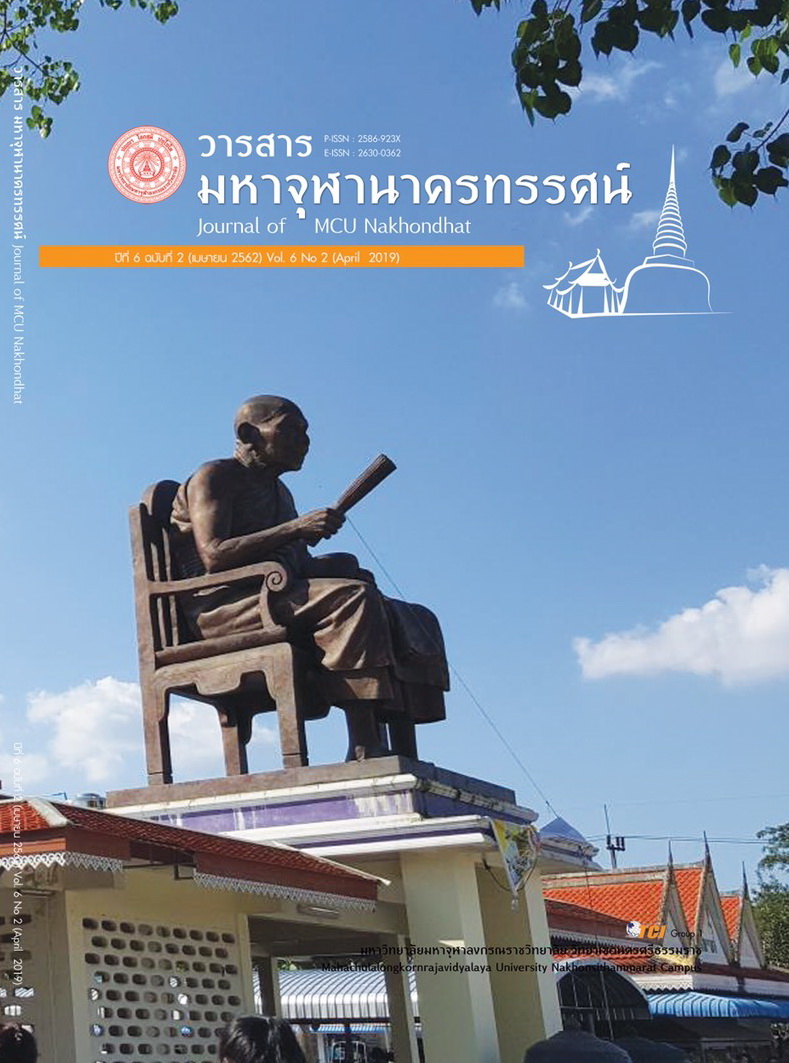THE EFFECT OF THAI WORDS THAT AN INFLUENCE ON DOMINANCE EMOTION IN YOUNG ADULTS.
Main Article Content
Abstract
The purpose of this experimental research was to design experimental activities of looking at Thai words which stimulated Dominance emotions in young adults.The participants were eighty students who were 40 males and 40 females from Burapha University in the academic year 2017, aged between 20 and 22 years. There are extravert and ambivert personality groups. The data were analyzed by using basic statistics, percentage, mean and standard deviation. Dominance emotional perception behavior between males and females who were extravert and ambivert personality was analyzed by two-way ANOVA.
The results showed that;
There was relation between gender and personality while looking at Thai words that stimulated by uncontrol emotion was significant different (p<.05). There were no difference between gender and personality of dominance emotion.
Article Details
References
Bradley, M. M., & Lang, P. J. (1999). Affective norms for English words (ANEW) : Instruction manual and affective ratings. Frontiers in Psychology.
Chivers, M. L., Seto, M. C., Lalumière, M. L., Laan, E., & Grimbos, T. (2010). Agreement of self-reported and genital measures of sexual arousal in men and women: A meta-analysis. Archives of Sexual Behavior.
Domes, G., Schulze, L., Böttger, M., et al. (2010). The neural correlates of sex differences in emotional reactivity and emotion regulation. Human Brain Mapping.
Edmond, W. A. & Kennedy, T. D. (2017). An Applied Reference Guide to Research Designs: Quantitative, Qualitative, and Mixed Methods (2nd ed.). California: Sage Publication.
Etkin, A., Egner, T., & Kalisch, R. (2011). Emotional processing in anterior cingulate and medial prefrontal cortex. Trends in Cognitive Sciences.
Faul, F., Erdfelder, E., Lang, A. G., & Buchner, A. (2007). G*Power 3: A flexible statistical power analysis program for the social, behavioral, and biomedical sciences. Behavior Research Methods.
Hare, T. A., Camerer, C. F., & Rangel, A. (2009). Self-control in decision-making involves modulation of the vmPFC valuation system. Science.
Kravitz, D. J., Saleem, K. S., Baker, C. I., Ungerleider, L. G., & Mishkin, M. (2013). The ventral visual pathway: An expanded neural framework for the processing of object quality. Trends in Cognitive Sciences.
Kryklywy, J. H., Nantes, S., & Mitchell, D. G. V. (2013). The amygdala encodes the level of perceived fear but not emotional ambiguity in visual scenes. Behavioral Brain .
Kurth, F., Zilles, K., Fox, P. T., Laird, A. R., & Eickhoff, S. B. (2010). A link between the systems: functional differentiation and integration within the human . Brain Structure and Function.
Lucas, R. E., & Baird, B. M. (2004). Extraversion and emotional reactivity. Journal of personality and social psychology, 86(3), 473.
Mendoza-Halliday, D., Torres, S., & Martinez-Trujillo, J. C. (2014). Sharp emergence of feature-selective sustained activity along the dorsal visual pathway. Nature Neuroscience.
Mochizuki, A. A., & Kirino, E. (2008). Effects of coordination exercises on brain activation:A functional MRI study. International Journal of Sport and Health Science.
Ngamprom, Chadcham, & Wongupparaj. (2560). Development of the Affective Norms for Thai Words (Thai-ANW) Bank System. Research Methodology and Cognitive Science.
Redondo, J., Fraga, I., Padrón, I., & Comesaña, M. (2007). The Spanish adaptation of ANEW (Affective norms for English words). Behavior Research Methods.
Schirmer, A., Kotz, S.A., & Friederici, A. D. (2005). On the role of attention for the processing of emotions in speech: Sex differences revisited. Cognitive Brian Research.
Schmidtke, D. S., Schroder, T., Jacobs, A. M., & Conrad, M. (2014). ANGST: affective norms for German sentiment terms, derived from the affective norms for words. Behavior Research Methods.
Soares, A. P., Comesaña, M., Pinheiro, A. P., Simões, A., & Frade, C. S. (2012). The adaptation of the Affective Norms for English words (ANEW) for European Portuguese. Behavior Research Methods.
Stadthagen-Gonzalez, H., Imbault, C., Sánchez, M. A. P., & Brysbaert, M. (2017). Norms of valence and arousal for 14,031 Spanish words. Behavior Research Methods.
Vuoskoski ,Eerola, T., J. K. (2011). A comparison of the discrete and dimensional models of emotion in music. Psychology of Music.
Watanabe, N., & Yamamoto, M. . (2015). Neural mechanisms of social dominance. Frontiers in Neuroscience.
Whittle, S., Yap, M. B., Sheeber, L., Dudgeon, P., Yücel, M., Pantelis, C., Simmons, J. G., Allen, N. B. (2011). Hippocampal volume and sensitivity to maternal aggressive behavior: A prospective study of adolescent depressive symptoms. Development and Psychopathology.


